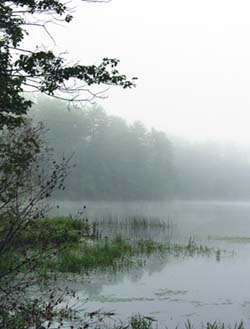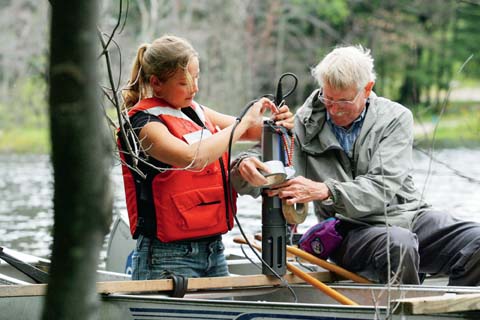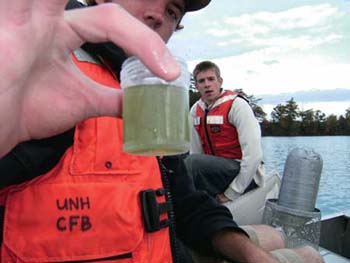 |
 |
| current issue |  | past issues |  | send a letter/news |  | address update |  | advertise |  | about us |  | alumni home |
Features
|
Dangerous Waters
Could there be a connection between blue-green algae and clusters of deadly neurological disease near our lakes? By Virginia Stuart '75 '80G |
Easy to print version Make a comment |
David Hersey spends most of his time propped up in bed in his living room these days. "I have one arm that still works," the former parachute rigger and skydiving enthusiast notes wryly as he extends his left hand to a visitor. It's been three years since he heard a neurologist say, in so many words, "You have ALS, there's no known treatment, and you're going to die." The doctor was only confirming what Hersey had already figured out from his own research after noticing that he kept stubbing his toe. Before that, the 58-year-old Deerfield, N.H., resident had never heard of amyotrophic lateral sclerosis, otherwise known as Lou Gehrig's disease.
 Frank LaFerriere
Frank LaFerriereWilland Pond |
Ever since, he's been watching it gradually creep upward, rendering his limbs useless while his sense of touch and mental abilities remain intact. "I will eventually die of respiratory failure," he says. Hersey, however, likes to point out that there is no typical ALS patient. He, for one, has little use for self-pity. "I don't have a list of things I didn't do," he explains. "I did them as I went along."
As his condition has progressed, his pursuits have taken an intellectual bent—learning Italian, exploring the Internet, and reading about ALS research, which, he's convinced, has made little progress since Yankees slugger Gehrig was diagnosed with the disease in 1939.
Elijah Stommel, a neurologist and researcher at Dartmouth-Hitchcock Medical Center, has been known to lie awake at night puzzling over possible causes of ALS. A few years ago, he started to notice clusters of ALS patients near lakes. At Mascoma Lake in Enfield, N.H., for example, he was seeing an occurrence of the disease roughly 25 times higher than expected. Around the same time, he read about a controversial theory linking ingestion of a toxin produced by blue-green algae to neurodegenerative diseases like ALS, Alzheimer's and Parkinson's. His search for a field biologist who could help him explore a possible connection between algae in lakes and ALS in lakeside residents led to Jim Haney, a UNH expert on aquatic organisms and the toxins they produce. Haney was also intrigued by the new theory.
One November day in 2007, Haney and graduate student Amanda Murby '06,'10G canoed out onto Mascoma Lake to get samples of the water and sediment. At the UNH Biotoxins Lab, the sediment revealed high levels of microcystin, a well-studied liver toxin produced by certain algae. Exposure through swimming can cause rashes and gastroenteritis, and ingestion of contaminated water has been blamed for animal and human deaths around the world. The neurotoxin suspected of causing ALS, the amino acid BMAA, has yet to be found in the lake. Although it is harder to identify and less well studied than microcystin, BMAA is produced by the same species of algae which was found in abundance in Mascoma. Later Murby mapped the algae in the lake, showing how currents could circulate the organisms toward the public beach in warm weather. Last summer, the N.H. Department of Environmental Services issued 17 advisories for harmful blue-green algae blooms at freshwater beaches, including Mascoma's.
Now Stommel asks all his new patients where they live and how long they have lived there. Using sophisticated geographical software, he and his colleague, neurologist Tracie Caller, have documented a significant statistical increase in the incidence of ALS cases near water bodies with a history of toxic algae blooms. They have also identified patients near these lakes who have developed some symptoms of ALS but not the full-blown disease.

|
| PROBING THE DEEP: Biologist Jim Haney and Amanda Murby '06, '10G measure the water of Willand Pond in Dover, N.H., for a number of parameters, including the concentration of microorganisms that produce liver and neurological toxins. |
In April, Haney and Stommel applied for a federal grant to study ALS clusters in northern New England and algae blooms in nearby lakes and waterways. If the research adds to the mounting evidence of a link between the disease and the algae, it could help light the way to a cure. But even if it doesn't, the researchers hope to raise awareness of a known health threat and to motivate the public to take better care of a beloved and valuable natural resource.
Jim Haney and his colleagues at the Biotoxins Lab, John Sasner and Mike Ikawa, were already experts on the deadly "red tide" algae when they got a call in 1997 from Silver Lake State Park in Hollis, N.H. Children who had been swimming in the lake were getting stomach ailments. Haney was surprised to find that water samples from the lake looked like a pure culture of the kind of algae that produces microcystin—in concentrations among the highest ever detected worldwide. He urged the state to keep children out of the water whenever the scum of an algae bloom formed. At the same time, he recognized "an unbelievable opportunity," and began to study blue-green algae.
Haney has a sort of scientific love-hate relationship with these microscopic organisms, which are actually bacteria and technically called cyanobacteria. They were here if not at the very dawn of life on Earth, then "only" about a billion years later. In fact, they were the first organisms to develop photosynthesis—producing the oxygen that enabled the rest of life as we know it to unfold.

|
| BOTTLED WATER: Michael Stuart '10, left, and Kevin Currier '10 sample the water in Barbadoes Pond in Madbury, N.H |
Today blue-green algae can be found virtually anywhere on the globe—in the middle of the ocean, a handful of desert sand, the fur of a sloth, a dietary supplement, a glass of water, or a leaf of lettuce. Viewed through a microscope, they reveal a beautiful symmetry in delicate spirals or straight chains like opened bracelets. To the naked eye, however, an algae bloom can resemble pea soup, green latex paint, white flakes or brown scum.
In 2003, New Hampshire became one of the first states to test for blue-green algae in its freshwater beach inspection program, which is directed by biologist Sonya Carlson '06G, a former student of Haney's. The state issues an advisory when algae levels at a public beach exceed the World Health Organization standards for drinking water. The beach manager must then post a sign and decide whether to close the beach for the duration of the bloom.
With the support of a federal grant, Haney and his colleagues have tested levels of microcystin in 80 of New Hampshire's 959 lakes, using the highly sensitive ELISA (enzyme-linked immunosorbent assay) method. "It's misleading to talk about lakes having toxic cyanobacteria or not," he says. "It's a matter of how much they have." He's seen a thousandfold difference in levels from the lowest to highest concentrations.
Easy to print version
blog comments powered by Disqus
